Abstract
A general linear model of familial resemblance is described which allows for cultural transmission from parent to offspring, polygenic inheritance, phenotypic assortative mating, common environment, maternal and paternal effects, and threshold effects. Three special cases are described in detail which are particularly useful when data are only available about a few classes of relatives reared in intact families. The cultural model, the polygenic model, and the pseudopolygenic model share the common feature that all factors which are transmitted from parent to offspring may be represented by one parameter without any loss of information. We introduce a new model, termed the unitary model, which includes these models and is appropriate when combined genetic and cultural transmission is present and when data are available only for individuals reared in intact nuclear families. The basic properties of these models are explored using path analysis and computer simulation, including description of the relationship between parameters under random and assortative mating, rate of approach to equilibrium, and constraints on the magnitude of the parameters. General formulae for familial resemblance in extended pedigrees are given for any ancestor or descendant of either vertical or collateral relatives. Estimation procedures are described and a FORTRAN program TAU, available upon request, is used to provide maximum likelihood estimates of the parameters from reported correlations. A powerful test for detecting the presence of cultural transmission is suggested and applied to simulated data and to data sets reported by others for human stature, for which cultural transmission is suggested. In addition, it is shown that there is no need to postulate dominance to account for available data about height.
Full text
PDF
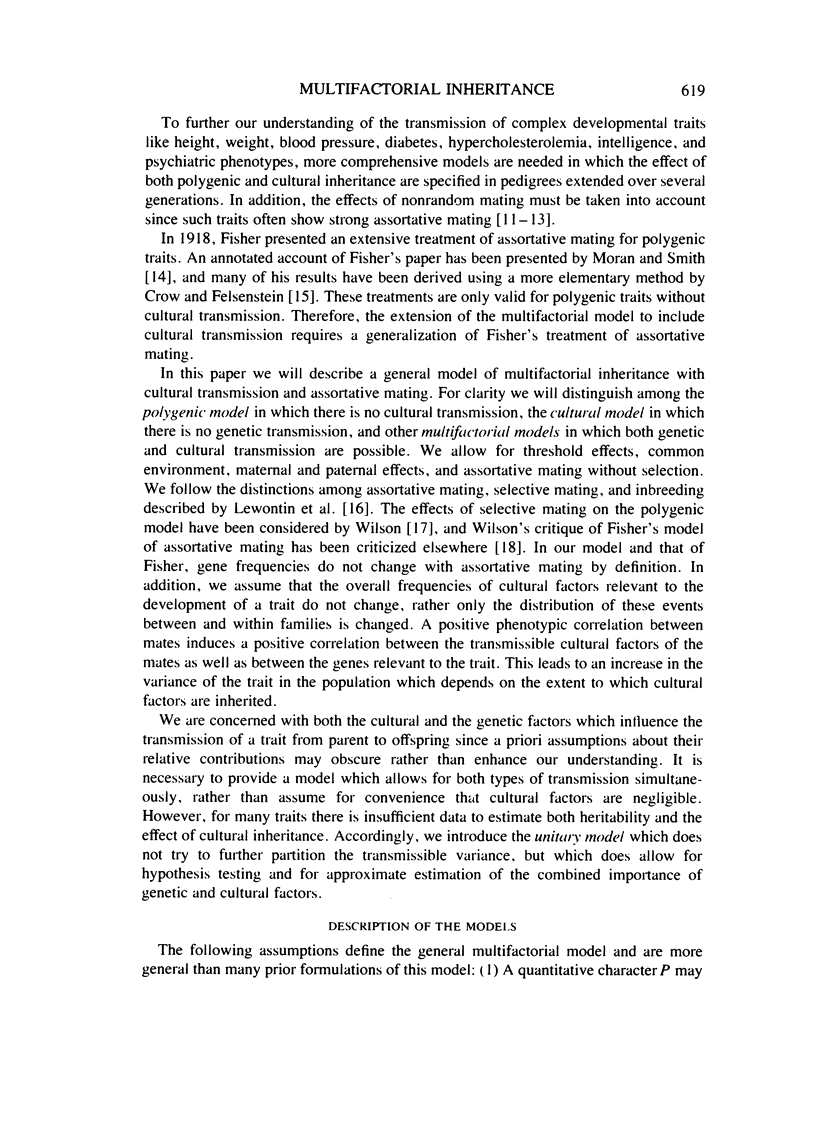


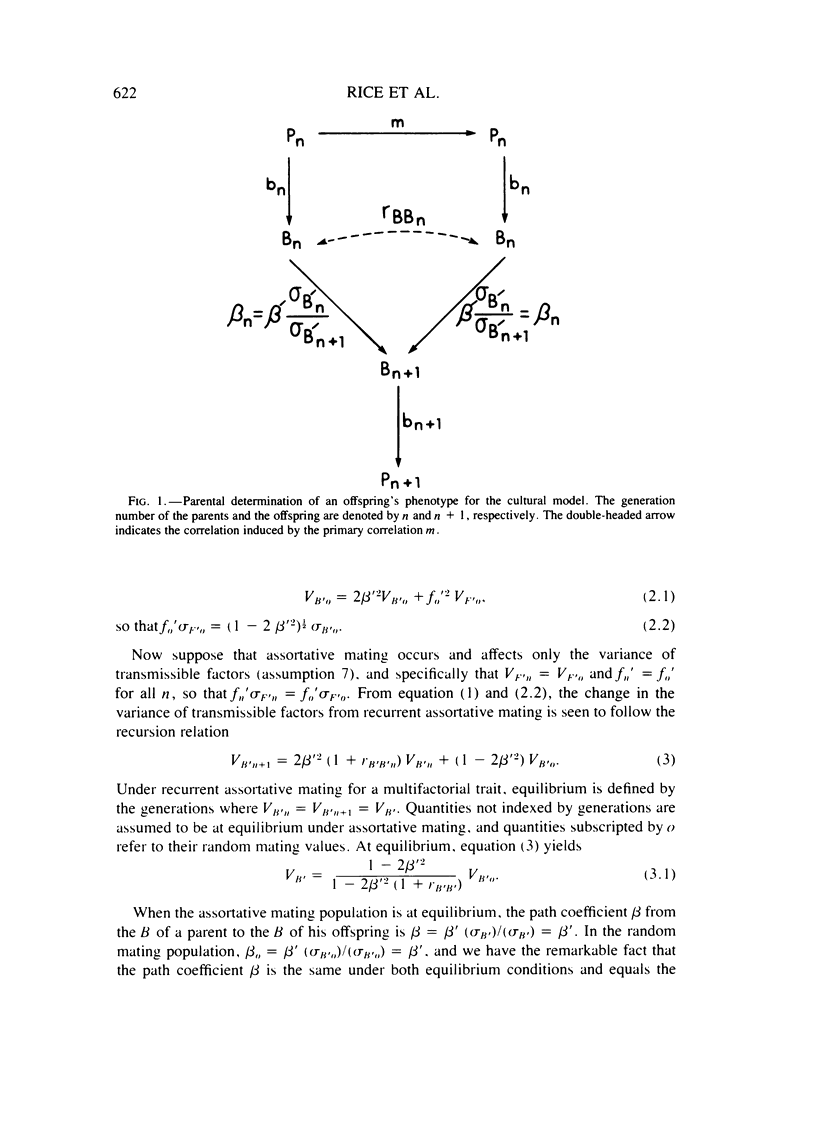
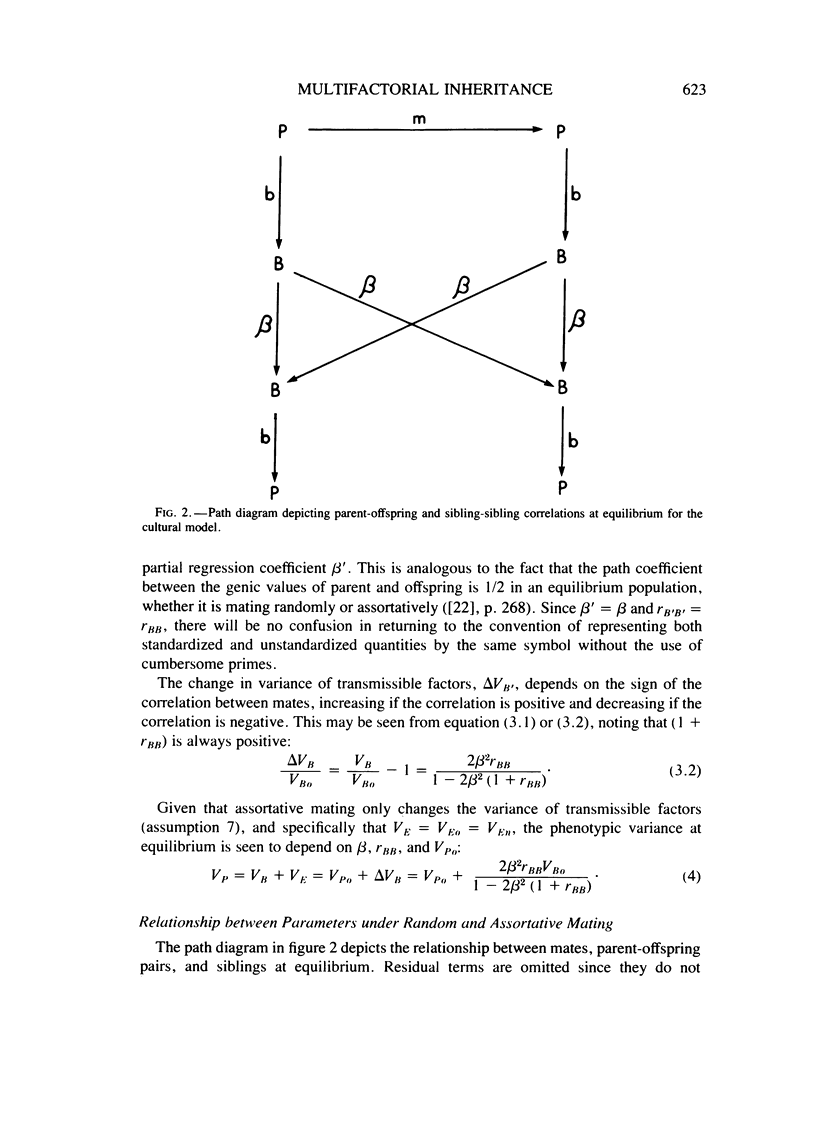



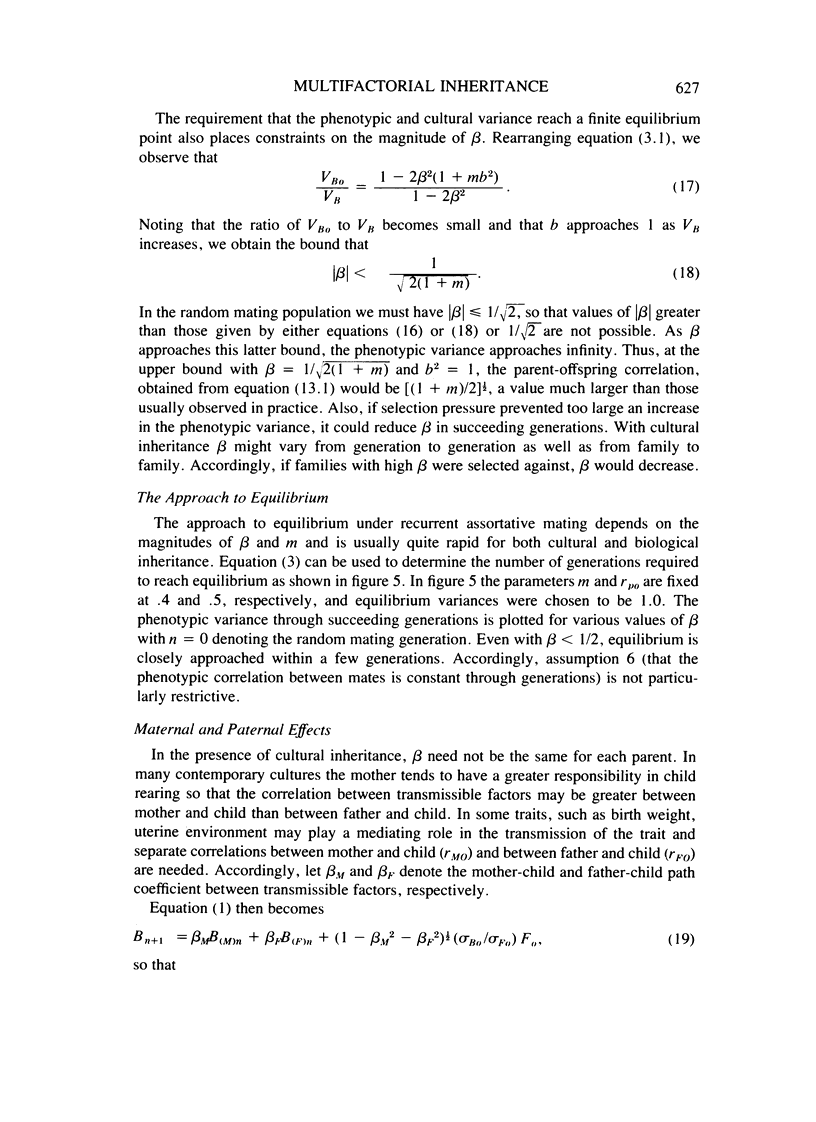



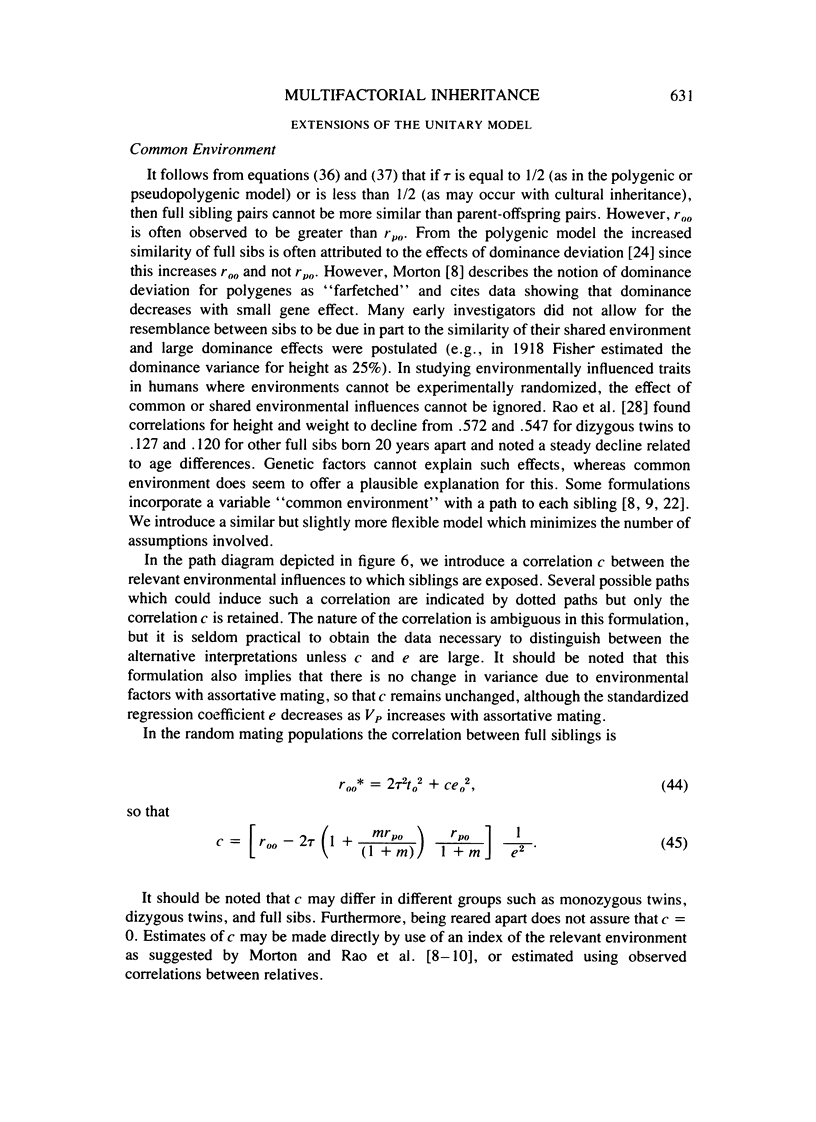








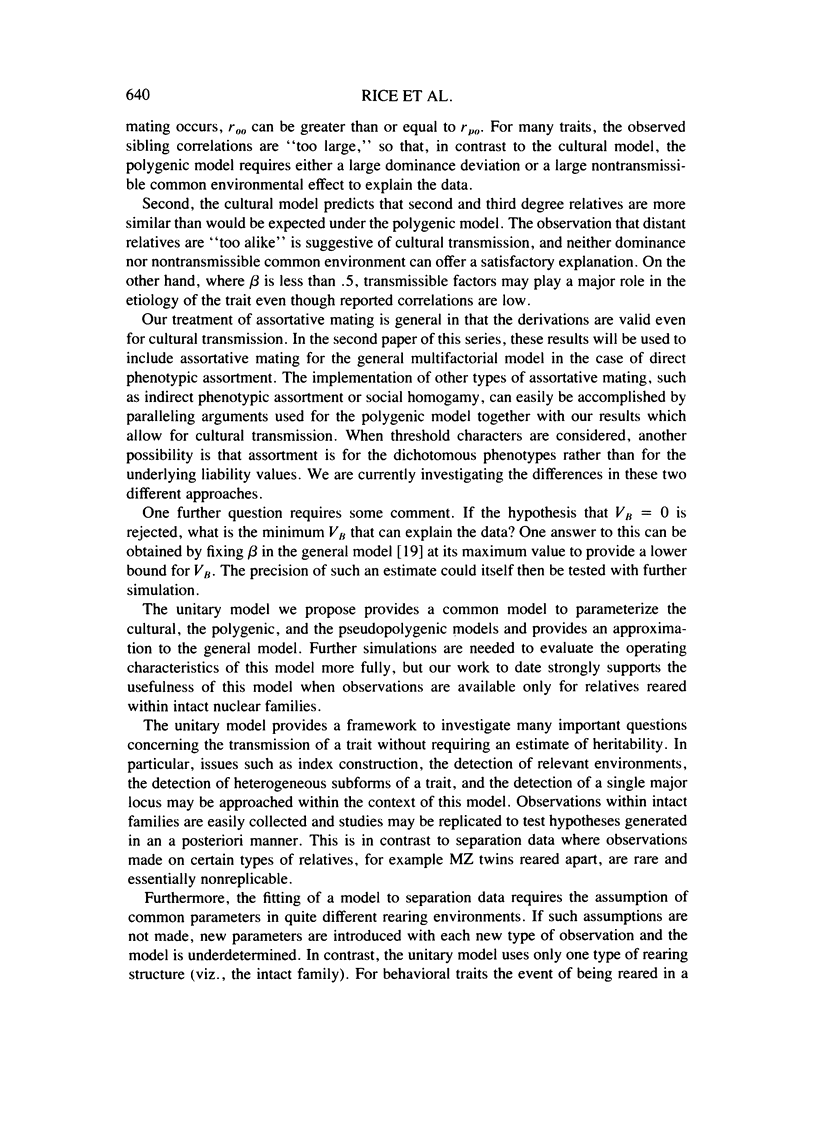



Selected References
These references are in PubMed. This may not be the complete list of references from this article.
- CRITTENDEN L. B. An interpretation of familial aggregation based on multiple genetic and environmental factors. Ann N Y Acad Sci. 1961 Jun 7;91:769–780. doi: 10.1111/j.1749-6632.1961.tb31106.x. [DOI] [PubMed] [Google Scholar]
- Carter C. O. Polygenic inheritance and common diseases. Lancet. 1969 Jun 21;1(7608):1252–1256. doi: 10.1016/s0140-6736(69)92130-8. [DOI] [PubMed] [Google Scholar]
- Cavalli-Sforza L. L., Feldman M. W. Cultural versus biological inheritance: phenotypic transmission from parents to children. (A theory of the effect of parental phenotypes on children's phenotypes). Am J Hum Genet. 1973 Nov;25(6):618–637. [PMC free article] [PubMed] [Google Scholar]
- Cavalli-Sforza L., Feldman M. W. Models for cultural inheritance. I. Group mean and within group variation. Theor Popul Biol. 1973 Mar;4(1):42–55. doi: 10.1016/0040-5809(73)90005-1. [DOI] [PubMed] [Google Scholar]
- Crow J. F., Felsenstein J. The effect of assortative mating on the genetic composition of a population. Eugen Q. 1968 Jun;15(2):85–97. doi: 10.1080/19485565.1968.9987760. [DOI] [PubMed] [Google Scholar]
- Lewontin R., Kirk D., Crow J. Selective mating, assortative mating, and inbreeding: definitions and implications. Eugen Q. 1968 Jun;15(2):141–143. doi: 10.1080/19485565.1968.9987764. [DOI] [PubMed] [Google Scholar]
- Morton N. E. Analysis of family resemblance. I. Introduction. Am J Hum Genet. 1974 May;26(3):318–330. [PMC free article] [PubMed] [Google Scholar]
- Rao D. C., MacLean C. J., Morton N. E., Yee S. Analysis of family resemblance. V. Height and weight in northeastern Brazil. Am J Hum Genet. 1975 Jul;27(4):509–520. [PMC free article] [PubMed] [Google Scholar]
- Rao D. C., Morton N. E., Yee S. Analysis of family resemblance. II. A linear model for familial correlation. Am J Hum Genet. 1974 May;26(3):331–359. [PMC free article] [PubMed] [Google Scholar]
- Rao D. C., Morton N. E., Yee S. Resolution of cultural and biological inheritance by path analysis. Am J Hum Genet. 1976 May;28(3):228–242. [PMC free article] [PubMed] [Google Scholar]
- Reich T., James J. W., Morris C. A. The use of multiple thresholds in determining the mode of transmission of semi-continuous traits. Ann Hum Genet. 1972 Nov;36(2):163–184. doi: 10.1111/j.1469-1809.1972.tb00767.x. [DOI] [PubMed] [Google Scholar]
- Spuhler J. N. Assortative mating with respect to physical characteristics. Eugen Q. 1968 Jun;15(2):128–140. doi: 10.1080/19485565.1968.9987763. [DOI] [PubMed] [Google Scholar]
- Vandenburg S. G. Assortative mating, or who marries whom? Behav Genet. 1972 Jun-Sep;2(2):127–157. doi: 10.1007/BF01065686. [DOI] [PubMed] [Google Scholar]
- Vetta A., Smith C. A. Comments on Fisher's theory of assortative mating. Ann Hum Genet. 1974 Oct;38(2):243–248. doi: 10.1111/j.1469-1809.1974.tb01954.x. [DOI] [PubMed] [Google Scholar]
- Wilson S. R. Simulation of Mendelism by a non-genetic Markov chain model. Ann Hum Genet. 1974 Oct;38(2):225–229. doi: 10.1111/j.1469-1809.1974.tb01952.x. [DOI] [PubMed] [Google Scholar]
- Wilson S. R. The correlation between relatives under the multifactorial model with assortative mating. I. The multifactorial model with assortative mating. Ann Hum Genet. 1973 Oct;37(2):189–204. doi: 10.1111/j.1469-1809.1973.tb01826.x. [DOI] [PubMed] [Google Scholar]
- Wolkind S. N. Sex differences in the aetiology of antisocial disorders in children in long term residential care. Br J Psychiatry. 1974 Aug;125(0):125–130. doi: 10.1192/bjp.125.2.125. [DOI] [PubMed] [Google Scholar]


